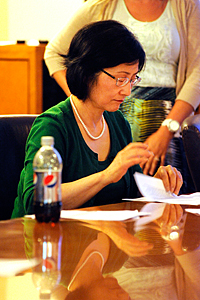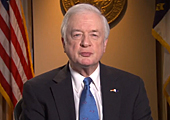High school science teacher wraps up a summer of exploration at NIEHS
By Darshini Trivedi

Estes described her experience at NIEHS with infectious enthusiasm. “I honestly didn’t know what a knockout mouse was until I got here,” she said. (Photo courtesy of Steve McCaw)

Huei-Chen Lao scans through one of Estes’ proposed lesson plans based on her research experience in the Langenbach lab. Lao said she wanted to enhance Estes’ understanding of the nature of science, as well as the essentials of basic mechanistic research. (Photo courtesy of Steve McCaw)
For high school science teacher Kelly Estes, this summer’s externship at NIEHS was an eye-opening, curriculum-enriching experience that culminated in an informal seminar Aug. 9. Speaking to a small group of colleagues at NIEHS, Estes described the ways her summer in the lab will benefit students when she begins her new year as a teacher at Broughton High School in Raleigh, N.C.
Estes is the first graduate of a new program launched by the NIEHS Office of Science Education and Diversity (OSED) this summer, called the Science, Teachers, and Research Summer (STaRS) Program, led by OSED Director Ericka Reid, Ph.D., in partnership with the North Carolina New Schools Project (NCNSP). (http://newschoolsproject.org/) STaRS provides outstanding high school science teachers an opportunity to work alongside top NIEHS scientists, to further their knowledge and experience in environmental health sciences research and expand their classroom curriculum.
Download Media Player: Flashhttp://get.adobe.com/flashplayer/
Estes, who spent her first year out of college teaching at South Granville High School, worked this summer with Huei-Chen Lao, a biologist in the Metabolism and Molecular Mechanisms Group of the Laboratory of Toxicology and Pharmacology, headed by lead researcher Robert Langenbach, Ph.D.
“The externship at NIEHS exceeded my expectations,” Estes told the audience. “It was such an educational and enlightening experience, and I can’t wait for the upcoming school year so that I can implement what I learned into my classroom. I feel that I have such a different outlook on research, and truly see how much research benefits society today.”
Mastering the essentials of basic research
Lao designed the externship with the goal of helping Estes gain a better understanding of the what, why, and how of basic science research, as well as an appreciation of the scope of the science at NIEHS. The main objective for Estes was to be able to translate this knowledge of basic biomedical research into the classroom. Estes participated in a variety of hands-on laboratory experiences, from excising skin tumor samples from mice and running western blot analysis of proteins extracted from the skin tumors, to performing histological and immunohistochemical staining of skin tumor cross-sections.
Estes worked closely with the immunohistochemistry and image analysis core labs at NIEHS, to perform part of these studies. She also drew upon the resources of the animal facility, knockout mouse core, the clinical research unit, viral vector core, microarray facility, and stem cell labs. Estes said that being exposed to the variety of research areas at NIEHS gave her a greater appreciation of the complexity of basic science research. She was also impressed with the amount of care that the animals received in the animal research facility, as she learned about the extensive rules and regulations that have to be followed in order to conduct animal research ethically and humanely.
Her experience at NIEHS has energized Estes with a new passion for science, and she feels more motivated than ever to ignite the same passion in her students. Estes believes that it is very important to make classroom material relevant to what her students are exposed to in their day-to-day lives, and she is eager to use her imagination and creativity to incorporate new ideas about emerging research into her classroom curriculum.
The state of North Carolina requires its teachers to follow certain essential standards when they design their lesson plans. One standard, Bio 3.3.2, specifies that students learn about how transgenic organisms are engineered to benefit society. Estes’ experience working with knockout mice in the Langenbach lab has given her a host of new ideas for lesson plans and modified laboratory activities, which will help satisfy the N.C. Essential Standards for teachers, while raising awareness about scientific research among her students.
(Darshini Trivedi, Ph.D., is an Intramural Research and Training Award fellow in the NIEHS Laboratory of Toxicology and Pharmacology.)

Reid explained that Estes’ program was one of several OSED outreach initiatives. “We are definitely trying to take more of what we do at NIEHS into the classroom,” she said. (Photo courtesy of Steve McCaw)

OSED Special Assistant for Community Engagement and Outreach John Schelp, center, browsed the N.C. Essential Standards for teachers, which Lao incorporated into the design of Estes’ externship program. (Photo courtesy of Steve McCaw)
"Possible mechanism between maternal ..." - previous story ![]()
![]() next story - "NIEHS workshop inspires new ..."
next story - "NIEHS workshop inspires new ..."
September 2012 Cover Page



